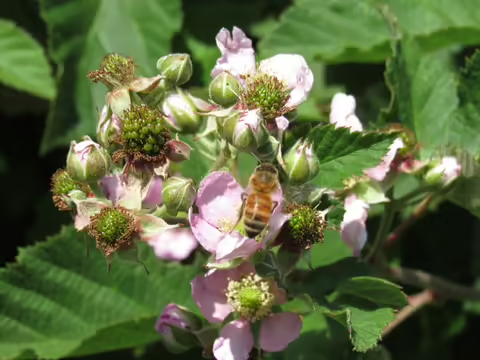When people hear the term “brambles”, they might not be familiar. What the heck is a bramble, you may ask? Or maybe you’ve heard the term, and likely it is a love or hate relationship for the reader here. “Brambles” to you could mean a garden or landscape problem, or a delicious summer treat! Let’s dive in!
Brambles are bush-like, thorny plants with arching canes that are all in the Rubus family of plants. This includes the common blackberry, raspberry (including red, black and yellow) and the less common dewberry and thimbleberry. Many of these species are grown or bred for their wonderful fruit, and there are many wild-growing brambles as well. Wild bramble fruits are generally smaller than their cultivated, on-farm cousins, but are more packed with flavor! It’s almost “brambleberry” foraging and harvesting time now; if you see anything in the woods that looks like store-bought raspberry or blackberry, it’s safe to eat! There are no poisonous look-alikes to worry about.
There is good news and bad news about plants in the bramble family. The plants root easily, they spread out, and they give off fruit every year. If you are trying to establish them in your garden, you’ll likely be successful; they are quite vigorous. Another plus is that they are an incredibly rich (and common) source of pollen for pollinators of all types. Expect new plants to bear fruit in their second year.
Now the bad news: they’re sharp! Wear gloves when doing anything with brambles except harvesting. Besides their pointy nature, there are two other drawbacks. First, if you are trying to get rid of them, it’ll take a few tries. The Rubus family members all have vigorous root systems that will resprout canes several times, even after being cut down to the ground. Second, brambles need to be pruned annually after the first two or three years. Pruning takes place between December and March when plants are fully dormant.
This Local Foods Educator actually enjoys pruning woody perennial crops in winter/early spring. It’s a good reason to get outside and get sun on your face when most of us could use some Vitamin D. Pruning can be quite meditative and satisfying. Not sure how to prune brambles? The internet is a great source for brambles pruning tips and how-to videos.
“Alright, get to the good stuff; where can I get these fruits if I don’t feel like hiking?” I am glad you asked! Head on over to the Refuge Food Forest (701 E Lincoln Street, Normal, IL) and get your hands on some blackberries and black raspberries. They will be ripe in a few weeks.
ABOUT THE AUTHOR: Nick Frillman is a Local Foods and Small Farms Educator serving Livingston, McLean & Woodford counties. A fourth-generation graduate from University of Illinois, Frillman has a B.A. with a double major of Political Science and Spanish and a M.S. in Crop Science with a focus on crop production. Before joining Illinois Extension, Frillman completed a field season of CSA and farmers’ market style production at a small “beyond-organic” vegetable farm in Sandy, Ore.
